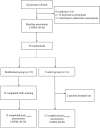Effect of home-based reablement program on improving activities of daily living for patients with stroke: A pilot study
- PMID: 33285763
- PMCID: PMC7717807
- DOI: 10.1097/MD.0000000000023512
Effect of home-based reablement program on improving activities of daily living for patients with stroke: A pilot study
Abstract
Background: Administering activities of daily living (ADL) and recovery of ADL functions are the main treatment goals in rehabilitation for patients with stroke. Reablement is one form of rehabilitative intervention, which aims to restore ADL functions performed in the community. The purpose of this study was to investigate the effects of home-based reablement from 3 concepts of ADL (ie, actual performance, ability, and self-perceived difficulty) for patients with stroke.
Methods: This was a single-blind pilot randomized clinical trial. Twenty-six patients were randomly assigned into 2 groups: home-based reablement group (n = 12) and control group (n = 14). The home-based reablement group received ADL training in the home environment for 6 weeks. The control group received conventional rehabilitation in the hospital. Outcome measures contained the Canadian Occupational Performance Measure (COPM) and the Barthel Index-based Supplementary Scales (BI-SS). The COPM was applied to identify patients' level of performance and satisfaction with ADL training. The BI-SS included 3 ADL scales: actual performance, ability, and self-perceived difficulty.
Results: The patients in the home-based reablement group showed statistically significant improvements in the ability scale and total score of the BI-SS than the control group (P < .05) and demonstrated moderate effect size (success rate difference = 0.34-0.42). No significant differences were noticed in the COPM and the other 2 scales of the BI-SS (actual performance and self-perceived difficulty), but small effect sizes were found (success rate difference = 0.17-0.22).
Conclusions: For patients with stroke, the 6-week home-based reablement program had similar effects with the control group on patients' perceived performance, satisfaction, and difficulty in ADL, but it displayed potential for enhancing their ability in executing ADL tasks.
Conflict of interest statement
The authors have no conflicts of interest to disclose.
Similar articles
-
Investigation of the home-reablement program on rehabilitation outcomes for people with stroke: A pilot study.Medicine (Baltimore). 2021 Jul 2;100(26):e26515. doi: 10.1097/MD.0000000000026515. Medicine (Baltimore). 2021. PMID: 34190182 Free PMC article. Clinical Trial.
-
Reablement of Instrumental Activities of Daily Living for Patients With Stroke: A Randomized Crossover Trial.Am J Occup Ther. 2024 Mar 1;78(2):7802180160. doi: 10.5014/ajot.2024.050288. Am J Occup Ther. 2024. PMID: 38305817 Clinical Trial.
-
Reablement in a community setting.Disabil Rehabil. 2015;37(15):1347-52. doi: 10.3109/09638288.2014.963707. Epub 2014 Sep 24. Disabil Rehabil. 2015. PMID: 25250811
-
The jigsaw puzzle of activities for mastering daily life; service recipients and professionals' perceptions of gains and changes attributed to reablement - A qualitative meta-synthesis.Scand J Occup Ther. 2023 Jul;30(5):604-615. doi: 10.1080/11038128.2022.2081603. Epub 2022 Jun 2. Scand J Occup Ther. 2023. PMID: 35655362 Review.
-
A systematic review and meta-analysis of reablement interventions for people in permanent residential aged care homes.Age Ageing. 2022 Oct 6;51(10):afac208. doi: 10.1093/ageing/afac208. Age Ageing. 2022. PMID: 36215172
Cited by
-
Effectiveness of Robotic Exoskeleton-Assisted Gait Training in Spinocerebellar Ataxia: A Case Report.Sensors (Basel). 2021 Jul 17;21(14):4874. doi: 10.3390/s21144874. Sensors (Basel). 2021. PMID: 34300613 Free PMC article.
-
Interprofessional homebased reablement intervention for older adults in Sweden: a randomized controlled trial.BMC Geriatr. 2025 Apr 10;25(1):242. doi: 10.1186/s12877-025-05886-w. BMC Geriatr. 2025. PMID: 40211212 Free PMC article. Clinical Trial.
-
Publication Trends in Reablement - A Scoping Review.J Multidiscip Healthc. 2023 Jun 13;16:1641-1660. doi: 10.2147/JMDH.S407802. eCollection 2023. J Multidiscip Healthc. 2023. PMID: 37333025 Free PMC article.
-
Adherence Rate, Barriers to Attend, Safety, and Overall Experience of a Remote Physical Exercise Program During the COVID-19 Pandemic for Individuals After Stroke.Front Psychol. 2021 Jul 9;12:647883. doi: 10.3389/fpsyg.2021.647883. eCollection 2021. Front Psychol. 2021. PMID: 34305716 Free PMC article.
-
Exploring behavior change techniques for reablement: A scoping review.Braz J Phys Ther. 2022 Mar-Apr;26(2):100401. doi: 10.1016/j.bjpt.2022.100401. Epub 2022 Apr 3. Braz J Phys Ther. 2022. PMID: 35427880 Free PMC article.
References
-
- Haghgoo HA, Pazuki ES, Hosseini AS, et al. Depression, activities of daily living and quality of life in patients with stroke. J Neurol Sci 2013;328:87–91. - PubMed
-
- Whyte EM, Mulsant BH. Post stroke depression: epidemiology, pathophysiology, and biological treatment. Biol Psychiatry 2002;52:253–64. - PubMed
-
- Clarke PJ, Lawrence JM, Black SE. Changes in quality of life over the first year after stroke: findings from the Sunnybrook Stroke Study. J Stroke Cerebrovasc Dis 2000;9:121–7. - PubMed
-
- Aspinal F, Glasby J, Rostgaard T, et al. New horizons: reablement-supporting older people towards independence. Age Ageing 2016;45:574–8. - PubMed
-
- Hjelle KM, Tuntland H, Forland O, et al. Driving forces for home-based reablement; a qualitative study of older adults’ experiences. Health Soc Care Community 2017;25:1581–9. - PubMed
Publication types
MeSH terms
LinkOut - more resources
Full Text Sources
Medical


